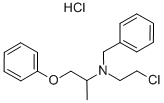Phenoxybenzamine HCl , ≥98% , 63-92-3
Synonym(s):
N-(2-Chloroethyl)-N-(1-methyl-2-phenoxyethyl)benzylamine hydrochloride;Phenoxybenzamine hydrochloride
CAS NO.:63-92-3
Empirical Formula: C18H22ClNO.ClH
Molecular Weight: 340.29
MDL number: MFCD00055152
EINECS: 200-569-7
| Pack Size | Price | Stock | Quantity |
| 1G | RMB218.40 | In Stock |
|
| 5G | RMB904.00 | In Stock |
|
| 25G | RMB2799.20 | In Stock |
|
| others | Enquire |
PRODUCT Properties
| Melting point: | 137.5°C |
| storage temp. | 15-25°C |
| solubility | soluble in organic solvents such as ethanol, DMSO, and dimethyl formamide (DMF). |
| form | powder |
| pka | pKa 4.4 (Uncertain) |
| color | white |
| Water Solubility | <0.01 g/100 mL at 18.5 ºC |
| Merck | 14,7256 |
| Stability: | Stable for 2 years as supplied. Solutions in DMSO or distilled water may be stored at -20°C for up to 3 months. |
| CAS DataBase Reference | 63-92-3(CAS DataBase Reference) |
| IARC | 2B (Vol. 24, Sup 7) 1987 |
| EPA Substance Registry System | N-(2-Chloroethyl)-N-(1-methyl-2-phenoxyethyl)benzylamine hydrochloride (63-92-3) |
Description and Uses
Phenoxybenzamine hydrochloride (dibenzyline) is an orally effective, long-acting non-selective (alpha1 and alpha2) alpha-adrenoceptor blocking agent. It is used for the control of episodes of hypertension associated withpheochromocytoma. It literally produces a "chemical sympathectomy". It increases blood flow to the skin, mucosa and abdominal viscera, and lowers both supine and erect blood pressures. It has no effect on the parasympathetic system. The initialdose is 10 mg/day, increased by 10 mg every 4 days till the desired response is attained.The usual dosage range is 20-60mg/day.
Phenoxybenzamine is used in treating pheochromocytoma, swelling of the medullary layer of the adrenal glands, during which a large quantity of epinephrine is produced, which leads to a significant elevation of blood pressure.
Safety
| Symbol(GHS) |   GHS07,GHS08 |
| Signal word | Warning |
| Hazard statements | H302-H351 |
| Precautionary statements | P201-P301+P312+P330-P308+P313 |
| Hazard Codes | Xn |
| Risk Statements | 22-40 |
| Safety Statements | 22-36/37/39-45 |
| WGK Germany | 3 |
| RTECS | DP3750000 |
| HS Code | 2922299000 |



